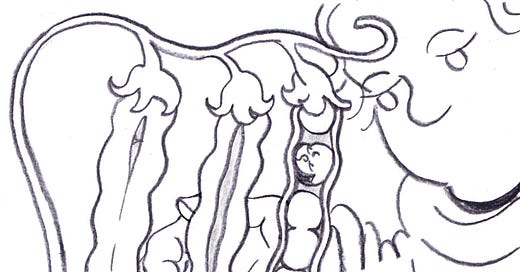Hey all,
Welcome to Human Nature, the illustrated psychology newsletter.
Today we’re going to talk about the most famous question in developmental psychology: what parts of our characteristics are biologically determined and what parts are shaped by our environment? Which is more important, nature or nurture?
Nature vs. nurture
Long before the discovery of genes, humans had an understanding that certain traits were passed down in families, from parents to their children. However, they were puzzled by the way in which some traits manifested in one sibling but not the other, or even yet were inherited by none, but mysteriously reappeared in the next generation.
The first knowledge of how characteristics are transmitted from parents to offspring came from the observations of a nineteenth century Austrian monk by the name of Gregor Mendel, who studied the inheritance patterns in pea plants in his monastery gardens. It was later discovered that these patterns are shared by other living things, including humans.
Mendel observed that certain characteristics in pea plants were passed down following a dominance pattern. We now know that this pattern is genetically determined. Some genes only have two forms, or alleles: a dominant one and a recessive one. An example of this is the gene for hair colour. The allele for brown hair is dominant while that for blond hair is recessive. If two parents with brown hair each possess the recessive allele for blond hair, there is a one in four chance that they will have blond haired children. However, most traits, especially those related to personality and behaviour, do not follow this Mendelian pattern. Their inheritance is much more complicated and is governed by multiple genes and environmental factors.
We all start out with the genetic material or genotype that we inherit from our parents. But not all of these genes are expressed over our lifetime. The timing, duration and environment in which genes are switched on determines their expression. The idea that any given genotype will develop differently in different environments, known as the norm of reaction, was first expressed by the Russian-American geneticist Dobzhansky in 1955. As we have seen from the Romanian orphanage studies, a loving and supportive environment will lead to very different developmental outcomes than one characterised by neglect. However, we have also seen that not every child was affected to the same degree by the same adverse conditions.
The reason for this variation is what we call gene-environment interaction. An example of this comes from a study showing the effects of childhood abuse on the later development of aggressive behaviour (Caspi et al., 2002). The researchers wanted to determine why certain children who are maltreated go on to become aggressive and antisocial while others do not. They suspected that it might have something to do with the MAOA gene, which is known to inhibit brain chemicals linked with aggression. They found that young men who possessed an inactive variant MAOA gene who had experienced parental abuse were much more likely to become violent adults than those who were abused but who possessed an active MAOA gene.
It hardly comes as a surprise that parents have a big influence on their children’s development, but children also play an active role in creating their own environment (Scarr & McCartney, 1983). Even young babies elicit different responses as a result of their temperament. For example, babies who enjoy cuddles are more likely to receive them than those who squirm away. Children also naturally surround themselves with objects or activities that match their interests and personalities, therefore shaping the environment in which they live.
As we have seen so far, genes and environment—or nature and nurture—are highly interlinked. But the question of how much is nature and how much is nurture still remains, and is the domain of behavioural genetics. By conducting family studies, behavioural geneticists compare the prevalence of traits in people with varying degrees of genetic relatedness and shared environments. For example, by comparing monozygotic twins to dizygotic twins, or monozygotic twins raised by different adoptive families, it is possible to estimate the heritability of a trait in a given population. However, heritability estimates are very limited in that they only apply to the studied population and are not generalisable, as environmental factors vary greatly from one population and one time period to another. The more our understanding of development advances, the clearer it becomes that nature cannot be separated from nurture, and vice versa.
Thank you for reading and see you next time.
Sources:
How Children Develop (Robert S. Siegler, Judy S. DeLoache, Nancy Eisenberg, 2010).
Role of genotype in the cycle of violence in maltreated children. (Caspi et al., 2002).





